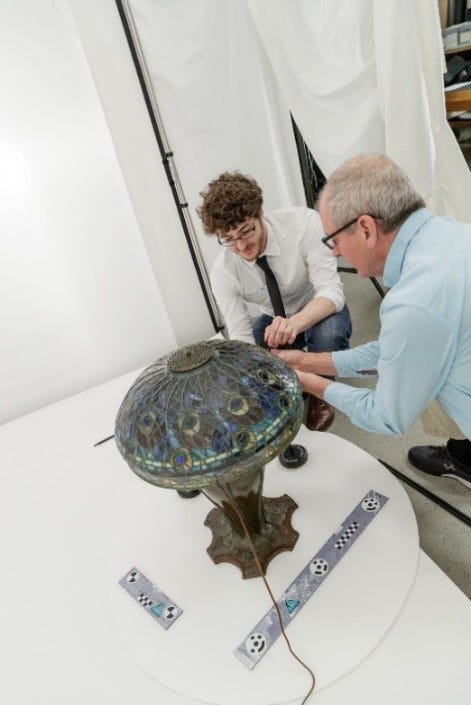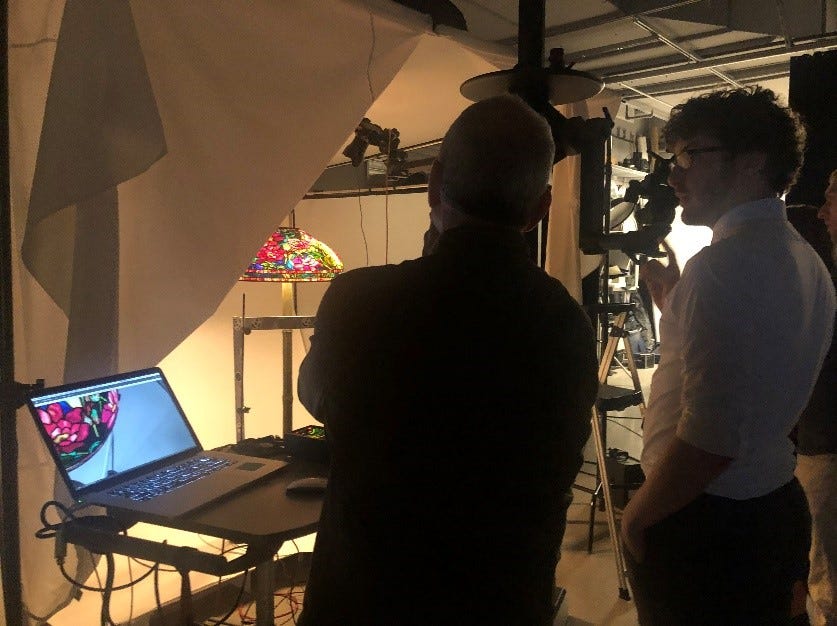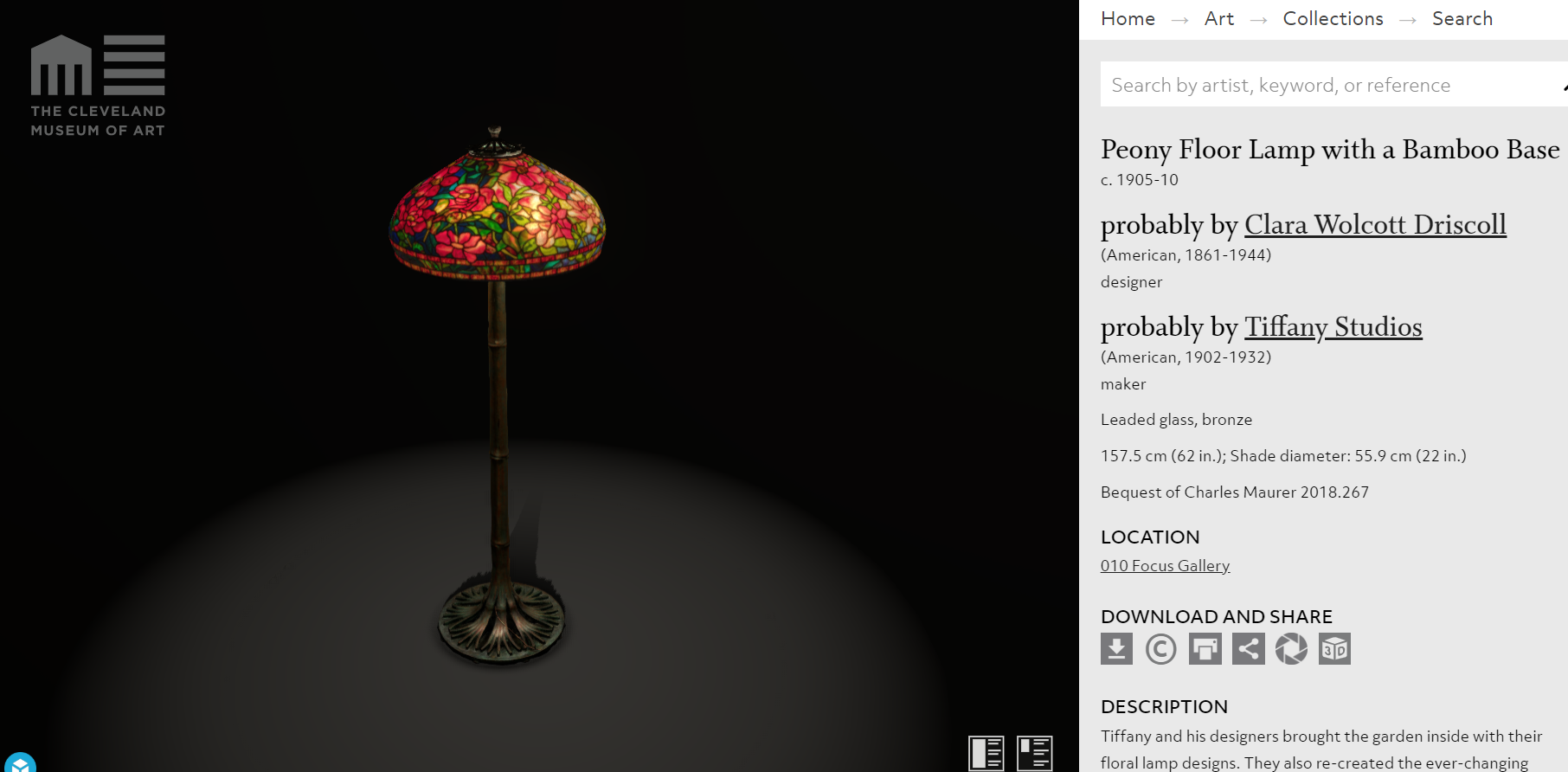In a New Light: Exploring the Design of Louis Comfort Tiffany’s Stained Glass Lamps
- Blog Post
- Digital Innovation
- Exhibitions

Tiffany in Bloom: Stained Glass Lamps of Louis Comfort Tiffany installation image. Courtesy Cleveland Museum of Art.
Tiffany in Bloom: Stained Glass Lamps of Louis Comfort Tiffany offers visitors a chance to view a vivid display of 20 Tiffany lamps recently acquired through a generous bequest to the museum. Focusing on Louis Comfort Tiffany’s passion for stained glass as a way to bring Nature’s splendid color into the home, this exhibition explores Tiffany’s vivid designs in relation to emerging artistic and craft movements at the turn of the 20th century.

Through the illuminated display of the designer’s finest stained glass table and floor lamps, as well as the iconic Hinds House Window, visitors can explore his method of design, production, and marketing; his reliance on women designers, such as Ohio native Clara Driscoll; and his alliances with both his father’s firm (Tiffany & Co.) and his European counterpart Siegfried Bing (Maison de l’Art Nouveau). The stained glass techniques used by Tiffany’s artisans reveal the firm’s unparalleled standard of quality and the designer’s love for the infinite possibilities of iridescence, texture, and color through manipulating light.


The CMA’s Digital Innovation team developed two interactives especially for this exhibition that help visitors understand the real-life use of two lamps, while highlighting their complex, intricate design: Peacock Table Lamp and Peony Lamp on a Bamboo Base. In the photo essay below, Maddie Armitage, digital project manager, discusses these interactives.

The Peacock Table Lamp is a rare example of an early lamp that employs a convertible lighting apparatus. To use electricity, the wick and chimney unscrew from the oil reservoir and the arms holding the electric lamps screw into the base. This mechanism allowed people who didn’t yet have electricity in their homes to enjoy Tiffany’s lamps. In the exhibition interactive, users can activate an animation that changes the light source from period Edison bulbs to an oil lamp.
Most of Tiffany’s shades and bases were meant to be interchangeable. The main feature of this lamp is the peacock feather, which is depicted in stained glass in the shade and in bronze and inlaid glass pieces on the base. When looking at this shade in the round or from overhead, it looks like the outstretched feathers of a preening male peacock. Within the exhibition interactive, users can activate an animation that depicts the view from above, allowing them to explore and look inside to see the many different varieties of Tiffany’s glass that produce the striking color, texture, and contrast of the design.


On the Peony Lamp on a Bamboo Base, the shade has dark colored peonies on one side that shielded the electric lamps at night and pale pink peonies on the other side to allow more light during sunny days. The shade easily rotates on its mount for this purpose. Within the exhibition interactive, users can activate an animation that digitally turns the shade from the night to the day side so users can see the visible contrast.


These two artworks were photographed in the CMA’s photo studio using photogrammetry, which can be understood as a way to visually represent real-world objects in a manner that combines photographic imaging with the metrics of scale.

To create a 3-D model using photogrammetry, a series of overlapping photographs are taken of an object, capturing every part of the object several times. Those images are then fed into a 3-D software program, which, after a series of processing steps, produces the 3-D model. Users can zoom in to explore details of these artworks while digitally turning them to see all the angles.


The photogrammetry showcases Tiffany’s technique of layering glass to produce shadowed effects and how pieces of glass were carefully cut and placed to produce striking contrasts in color and texture. The use of glass with swirls and imperfections also created depth and contrast.


These two lamps represent some of the most complicated 3-D models of museum artworks. Reproducing the exquisite colors and complex textures of Tiffany glass poses a challenge in any media, but especially with 3-D modeling. Capturing the combination of translucency, polished surfaces, and illumination is driving the teams at the CMA to explore the very edge of modern 3-D capturing techniques.
Creating the interactive:
The two 3-D photogrammetry models were animated in a program called Blender. The animated models were then uploaded to Sketchfab. Next, the Skethfab’s Viewer API was used in conjunction with Facebook’s React library to build the interactive interface around the models and animations. Finally, the scene’s lighting was manually added to match the models’ animations.
Interested in exploring the models off-site? Check them out on the CMA’s Collection Online by selecting the 3-D icon on the artwork pages: Peacock Table Lamp and Peony Lamp on a Bamboo Base. Explore all of the CMA’s 3-D models on our redesigned Collection Online.


The CMA’s cross-departmental team collaborated with photogrammetry expert Dale Utt, who created the 3-D models and animation with support from the CMA’s chief photographer, Howard Agriesti. Michael Dreiling, the CMA’s lead developer, then integrated the photogrammetry and created the interactives on Surface Pro tablets.
Tiffany in Bloom celebrates an unprecedented opportunity to view many of Tiffany’s great lamps together. The exhibition is on view in the CMA’s Julia and Larry Pollock Focus Gallery through June 14, 2020.